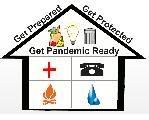# 2723
While this blog deals with pandemic influenza, and emerging infectious diseases, the primary focus is all about preparedness.
As individuals, as neighborhoods, and as communities.
Right now more than 1 million Americans are icebound, and without electricity (and in some cases heat) in the heartland after a major winter storm.
Some areas may not see their power restored for 2 weeks or more.
The Red Cross is reporting (RedCross) more than 3,000 people are being housed in emergency shelters in Kentucky, Arkansas, and Missouri.
There are fears that some people may literally freeze to death, or succumb to carbon monoxide poisoning from make-shift heating arrangements, in their homes.
This report from the AP. Then some discussion.
Thousands may face frigid, lightless nights ahead
Jan 29, 6:55 AM (ET)
By BRUCE SCHREINER(AP) Rick Lucas of the Dayton, Ky., Department of Public Works prepares to move a resident's car after a...
LOUISVILLE, Ky. (AP) - More than a million people stranded in darkness Thursday in the wake of an icy winter storm could face a lengthy wait for electricity to course through their frosty homes, even as federal help was promised to two states hit hardest by the blast.
Late Wednesday, President Barack Obama signed requests from Kentucky Gov. Steve Beshear and Arkansas Gov. Mike Beebe for federal emergency declarations. Crews - even the National Guard in Kentucky - worked around the clock to resurrect power lines downed by thick ice in both states. Officials in states from Oklahoma to West Virginia fought to do the same.
Utility officials estimated more than 1.31 million homes and businesses across a wide swath of states were powerless early Thursday, and warned it could be mid-February before some customers had power. The storm has been blamed for at least 23 deaths so far.
Many flocked to shelters, while others huddled next to wood-burning fires and portable heaters to fend off the frigid night air. Some who stayed put relied on gas stoves to cook food. Meanwhile, emergency officials feared the crisis could escalate as temperatures plunged.
As a native Floridian, I'm used to being prepared for Hurricanes. When I lived in Missouri (which I did for about 10 years), we dealt with ice and snow, tornadoes in the Spring . . . and the potential of an earthquake from the New Madrid fault.
Fortunately, we had no significant earth movements, but I was once icebound on our property for 3 weeks, unable to get out our 1/4th mile drive. We had wood heat, 5 cords of wood stockpiled, generators, fuel, and ample supplies.
So, to us, it wasn't an emergency.
But to others, less prepared, it became a life-or-death event.
Preparedness, whether it be for an ice storm, a hurricane, a tornado (tornado season is not far away), an earthquake . . . or even a pandemic - is everyone's responsibility.
The Red Cross, Salvation Army, and FEMA can provide aid, but not always as quickly as they would like. People need to be able to deal with disasters for at least the first 72 hours on their own.
The Federal government wants you, your family, and your business to be prepared. They know that that bad things happen all the time, and that being prepared is the best insurance policy of all.
They urge you to GET A KIT, MAKE A PLAN, and to BE INFORMED.
The government wouldn't be spending the kind of resources they do each year touting preparedness if they didn't think it was worth doing.
Every family, and every business, needs a COOP - or Continuity Of Operations Plan. Governments do it, Fortune 500 businesses do it, and so should you.
There are many degrees of preparedness, of course. At the very least, every family should have 3 days worth of food and water on hand, along with flashlights, a first aid kit, and a battery operated radio.
But that is just the start of what needs to become a culture of preparedness in our country, and around the world.
Once you have the basic 72 hour kit in place, it is time to start working on a 2-week kit. And once you've reached 2-weeks, it is time to look beyond that.
Given the uncertainties that the future holds, it only makes sense to make 2009 the year that you, your family, and your business becomes better prepared to face an emergency.
A few good places to get started are:
FEMA http://www.fema.gov/index.shtm
READY.GOV http://www.ready.gov/
AMERICAN RED CROSS http://www.redcross.org/
For Pandemic Preparedness Information: HHS Individual Planning Page
For more in-depth emergency preparedness information I can think of no better resource than GetPandemicReady.Org.
Admittedly, as a minor contributor to that site, I'm a little biased.
But whether you are preparing for a hurricane, an earthquake, a pandemic, or a terrorist attack - the important thing is not to delay.
Ready or not, the next disaster will likely come with very little warning.
Related Post:
Widget by [ Iptek-4u ]


